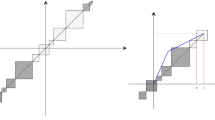Abstract
The purpose of this study is to probe the transformations that preserve capacities, their ergodicity and mixing behaviors. Firstly, definitions of different levels of mixing and ergodicity are introduced. Then attention is paid to continuous transformations on topological spaces with invariant capacities on Borel \(\sigma \)-algebra. The main results include that strong mixing implies ergodicity and weak mixing implies weak ergodicity. Moreover, limit properties of mixing capacity preserving dynamical systems and connections between a capacity preserving dynamical system and its product system are also discussed. The novelty of this study is that we present several topological characterizations of ergodic and mixing capacity preserving dynamical systems.
Similar content being viewed by others
Data availability
Enquiries about data availability should be directed to the authors.
References
Ali Shah R, Asghar Z, Ali N (2022) Mathematical modeling related to bacterial gliding mechanism at low Reynolds number with Ellis Slime. Eur Phys J Plus 13:137:600
Asghar Z, Waqas M et al (2020) Locomotion of an efficient biomechanical sperm through viscoelastic medium. Biomech Model Mechanobiol 19:2271–2284
Asghar Z, Ali N (2021) Dynamical interaction effects on soft-bodied organisms in a multi-sinusoidal passage. Eur Phys J Plus 136:693
Cerreia-Vioglio S, Maccheroni F, Marinacci M (2016) Ergodic theorems for lower probabilities. Proc Amer Math Soc 144:3381–3396
Choquet G (1954) Theory of capacities. Ann Inst Fourier Grenoble 5:131–295
Denneberg D(1994) Non-additive measure and integral. Theory and decision library. Series B: mathematical and statistical methods 27. Kluwer Academic Publishers Group, Dordrecht. (1994)
Feng CR, Wu PY, Zhao HZ (2020) Ergodicity of invariant capacities. Stoch Proc Appl. https://doi.org/10.1016/j.spa.2020.02.010
Gilboa I (1987) Expected utility theory with purely subjective non-additive probabilities. J Math Econ 16:65-68
Gilboa I (2004) Uncertainty in economic theory: essays in honor of David Schmeidler’s 65th birthday. Routledge, New York, Routledge Frontiers of Political Economy, p 63
Gu LJ, Li ZM Metric entropy of capacity preserving dynamical systems. Fuzzy Set Syst
Huber PJ (1973) The use of Choquet capacities in statistics. Bull Inst Int Stat 45:181–191
Kakutani S (1973) Examples of ergodic measure preserving transformations which are weakly mixing but not strongly mixing. In: Beck A (ed) Recent advances in topological dynamics. Springer, New York
Khan M, Asghar Z (2018) A novel construction of substitution box for image encryption applications with Gingerbreadman chaotic map and \(S_{8}\) permutation. Neural Comput Appl 29(4):993–999
Liu BD (2007) Uncertainty theory. Springer-Verlag, New York-Berlin
Liu BD (2010) Uncertainty theory: a branch of mathematics for modeling human uncertainty. Springer-Verlag, New York-Berlin
Maccheroni F, Marinacci M (2005) A strong law of large number for capacities. Ann Probab 33:1171–1178
Marinacci M (1999) Limit laws for non-additive probabilities and their frequentist interpretation. J Econom Theory 84:145–195
Marinacci M, Montrucchio L (2004) Introduction to the mathematics of ambiguity. In: Gilboa I. (ed) Uncertainty in economic theory: essays in Honor of David Schmeidler’s 65th Birthday. Routledge: New York. pp. 46-107
Peng SG(2010) Nonlinear expectations and stochastic calculus under uncertainty-with robust central limit theorem and G-Brownian motion. Available at arXiv:1002.4546v1
Shafer G (1976) A mathematical theory of evidence. Princeton University Press, Princeton
Schmeidler D (1989) Subjective probability and expected utility without additivity. Econometrica 57:571–587
Terán P (2014) Laws of large numbers without additivity. Trans Amer Math Soc 366:5431–5451
Wakker P (2004) Testing and characterizing properties of nonadditive measures through violations of the sure-thing principle. Econometrica 69:1039–1059
Walley P (1991) Statistical reasoning with imprecise probabilities. Monographs on statistics and applied probability. Chapman and Hall Ltd, London
Walters P (1982) An introduction to ergodic theory. Graduate texts in mathematics 79, Springer-Verlag: New York-Berlin
Wang ZY, Klir GJ (2008) Generalized measure theory, vol 25. IFSR international series on systems science and engineering. Springer, New York-Berlin
Wang ZY, Klir GJ (1992) Fuzzy measure theory. Springer-Verlag, New York-Berlin
Wu HY, Li ZM (2022) Ergodic theorems for capacity preserving \({\mathbb{Z} }_+^d\)-actions. Int J Approx Reason 146:1–20
Yao X, Ke H (2014) Poinc\(\acute{a}\) recurrence theorem in regular uncertain dynamic system. Fuzzy Optim Decis Mak 13:319–328
Funding
This second author is supported by the National Natural Science Foundation of China (12271432) and the Natural Science Foundation of Shaanxi Province (2020JC-39).
Author information
Authors and Affiliations
Contributions
LG was responsible for conceptualization and writing the original draft. GW polished the language and edited the manuscript, ZL took part in supervision, and writing, reviewing and editing the manuscript.
Corresponding author
Ethics declarations
Conflict of interest
There is no conflict of interest.
Ethical approval
This article does not contain any studies with human participants or animals performed by any of the authors.
Additional information
Publisher's Note
Springer Nature remains neutral with regard to jurisdictional claims in published maps and institutional affiliations.
Rights and permissions
Springer Nature or its licensor holds exclusive rights to this article under a publishing agreement with the author(s) or other rightsholder(s); author self-archiving of the accepted manuscript version of this article is solely governed by the terms of such publishing agreement and applicable law.
About this article
Cite this article
Guo, L., Wei, G. & Li, Z. Mixing of capacity preserving dynamical systems. Soft Comput 27, 219–225 (2023). https://doi.org/10.1007/s00500-022-07576-w
Accepted:
Published:
Issue Date:
DOI: https://doi.org/10.1007/s00500-022-07576-w




